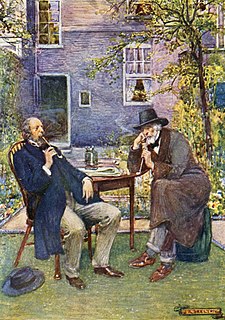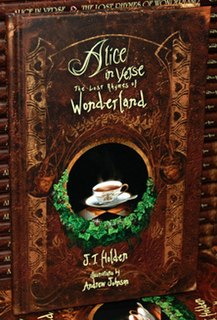Related Research Articles

"Jabberwocky" is a nonsense poem written by Lewis Carroll about the killing of a creature named "the Jabberwock". It was included in his 1871 novel Through the Looking-Glass, the sequel to Alice's Adventures in Wonderland (1865). The book tells of Alice's adventures within the back-to-front world of Looking-glass world.

Through the Looking-Glass, and What Alice Found There is a novel published on 27 December 1871 by Lewis Carroll and the sequel to Alice's Adventures in Wonderland (1865). Alice again enters a fantastical world, this time by climbing through a mirror into the world that she can see beyond it. There she finds that, just like a reflection, everything is reversed, including logic.

Humpty Dumpty is a character in an English nursery rhyme, probably originally a riddle and one of the best known in the English-speaking world. He is typically portrayed as an anthropomorphic egg, though he is not explicitly described as such. The first recorded versions of the rhyme date from late eighteenth-century England and the tune from 1870 in James William Elliott's National Nursery Rhymes and Nursery Songs. Its origins are obscure, and several theories have been advanced to suggest original meanings.

Alice's Adventures in Wonderland is an 1865 English novel by Lewis Carroll. It details the story of a young girl named Alice who falls through a rabbit hole into a fantasy world of anthropomorphic creatures. It is seen as an example of the literary nonsense genre. The artist John Tenniel provided 42 wood engraved illustrations for the book.

Alice is a fictional character and the main protagonist of Lewis Carroll's children's novel Alice's Adventures in Wonderland (1865) and its sequel, Through the Looking-Glass (1871). A child in the mid-Victorian era, Alice unintentionally goes on an underground adventure after accidentally falling down a rabbit hole into Wonderland; in the sequel, she steps through a mirror into an alternative world.

Alice Pleasance Hargreaves, was an English woman who, in her childhood, was an acquaintance and photography subject of Lewis Carroll. One of the stories he told her during a boating trip became the children's classic 1865 novel Alice's Adventures in Wonderland. She shared her name with "Alice", the heroine of the story, but scholars disagree about the extent to which the character was based upon her.

Tom Hood was an English humorist and playwright, and a prolific author. He was the son of the poet and author Thomas Hood. Pen and Pencil Pictures (1857) was the first of his illustrated books. His most successful novel was Captain Master's Children (1865).
Narrative poetry is a form of poetry that tells a story, often using the voices of both a narrator and characters; the entire story is usually written in metered verse. Narrative poems do not need rhyme. The poems that make up this genre may be short or long, and the story it relates to may be complex. It is normally dramatic, with various characters. Narrative poems include all epic poetry, and the various types of "lay", most ballads, and some idylls, as well as many poems not falling into a distinct type.

Victorian literature refers to English literature during the reign of Queen Victoria (1837–1901). The 19th century is considered by some to be the Golden Age of English Literature, especially for British novels. It was in the Victorian era that the novel became the leading literary genre in English. English writing from this era reflects the major transformations in most aspects of English life, from scientific, economic, and technological advances to changes in class structures and the role of religion in society. Famous novelists from this period include Charles Dickens, William Thackeray, the three Brontë sisters, George Eliot, and Thomas Hardy.

Children's poetry is poetry written for, appropriate for, or enjoyed by children.
The Spider and the Fly is a poem by Mary Howitt (1799–1888), published in 1829. The first line of the poem is "'Will you walk into my parlour?' said the Spider to the Fly." The story tells of a cunning spider who entraps a fly into its web through the use of seduction and manipulation. The poem is a cautionary tale against those who use flattery and charm to disguise their true intentions.

Lewis Carroll's books Alice's Adventures in Wonderland (1865) and Through the Looking-Glass (1871) have been highly popular in their original forms, and have served as the basis for many subsequent works since they were published. They have been adapted directly into other media, their characters and situations have been appropriated into other works, and these elements have been referenced innumerable times as familiar elements of shared culture. Simple references to the two books are too numerous to list; this list of works based on Alice in Wonderland focuses on works based specifically and substantially on Carroll's two books about the character of Alice.

Literary nonsense is a broad categorization of literature that balances elements that make sense with some that do not, with the effect of subverting language conventions or logical reasoning. Even though the most well-known form of literary nonsense is nonsense verse, the genre is present in many forms of literature.
"The Mouse's Tale" is a shaped poem by Lewis Carroll which appears in his 1865 novel Alice's Adventures in Wonderland. Though no formal title for the poem is given in the text, the chapter title refers to "A Long Tale" and the Mouse introduces it by saying, "Mine is a long and sad tale!" As well as the contribution of typography to illustrate the intended pun in this title, artists later made the intention clear as well. Translators of the story also encountered difficulty in conveying the meaning there, part of which was not recognised until well over a century later.

The Mouse is a fictional character in Lewis Carroll's 1865 novel Alice's Adventures in Wonderland. He appears in Chapter II "The Pool of Tears" and Chapter III "A Caucus-Race and a Long Tale".

Automated Alice is a fantasy novel by British author Jeff Noon, first published in 1996. The book follows Alice's travels to a future Manchester city populated by Newmonians, Civil Serpents and a vanishing cat.
"All in the golden afternoon" is the preface poem in Lewis Carroll's 1865 book Alice's Adventures in Wonderland. The introductory poem recalls the afternoon that he improvised the story about Alice in Wonderland while on a boat trip from Oxford to Godstow, for the benefit of the three Liddell sisters: Lorina Charlotte, Alice Pleasance, and Edith Mary. Alice gave her name to Carroll's main character.

Alice in Verse: The Lost Rhymes of Wonderland (2010) is a reimagining of Lewis Carroll's 1865 novel Alice's Adventures in Wonderland written by British-American author J.T. Holden. It tells the story of Alice's Adventures in Wonderland in 19 rhyming poems, each written in the same style as Lewis Carroll's original verse. The book includes 36 illustrations by American artist Andrew Johnson.

"The Mock Turtle's Song", also known as the "Lobster Quadrille", is a song recited by the Mock Turtle in Lewis Carroll's 1865 novel Alice's Adventures in Wonderland, accompanied by a dance. It was taught to him at school by his teacher called Tortoise.

Amy Millicent Sowerby (1878–1967) was an English painter and illustrator, known for her illustrations of classic children's stories such as Alice's Adventures in Wonderland and A Child's Garden of Verses, her postcards featuring children, nursery rhymes, and Shakespeare scenes, and children's books created with her sister Githa Sowerby.